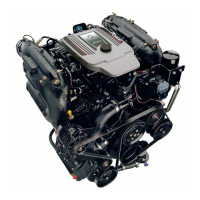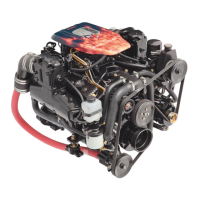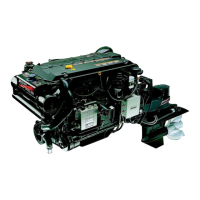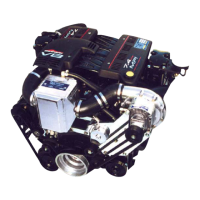Exhaust System
90-863758060 AUGUST 2006 Page 6A-21
10. Continue the process moving forward toward the bow of the boat to the next row of
seats until a person weight is loaded into each seat.
EXAMPLE
NOTE: The following example is provided as a reference.
This example uses a boat that is 8.84 m (29 ft.) long and greater than 8.84 m (29 ft.) long,
that does not have a maximum rated swim platform weight capacity, and must add
226.80 Kg (500 lb.) to the swim platform .
IMPORTANT: The Designated Seating Diagram following illustrates the number of
passengers that can sit on designated seating excluding cabin space.
Designated Seating Diagram
This example uses 9 persons as the maximum passenger load.
NOTE: Use 0.50 lb. as the break point to round up or down to obtain a whole pound.
1. To determine the maximum cargo load multiply the maximum passenger load by the
maximum cargo weight per passenger.
• 9 passengers × 25 lb. = 225 lb.
2. To determine the preferred cargo distribution for aft, center, and bow storage:
a. To determine the maximum aft storage cargo weight, multiply the maximum cargo
weight by 25%
3. To determine the maximum center storage cargo weight, multiply the maximum cargo
weight by 50%
a. 225 lb. × 50% = 112.50 lb.
b. 112.50 lb. rounded up = 113 lb.
4. To determine the maximum bow storage cargo weight, multiply the maximum cargo
weight by 25%
• 225 lb. × 25% = 56.25 lb.
• 56.25 lb. rounded down = 56 lb.
5. To determine the maximum number of passengers to load onto the boat, multiply 9
passengers by 165 lb. (MerCruiser person weight) to get a 1485 lb. (total passenger
load)
• 9 passengers × 165 lb. = 1485 lb.
6. Subtract the swim platform load from the total passenger load to get the remaining
weight to be placed in the boat.
• 1485 lb. – 500 lb. = 985 lb.
7. Divide the remaining weight to be placed onto the boat by the MerCruiser person weight
to get the maximum number of passengers to load onto the boat.
• 985 lb. ÷ 165 lb. = 5.9 passengers
• 5.90 passengers rounded up = 6 passengers

